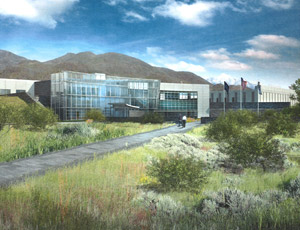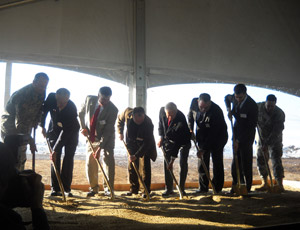Construction on the nation�s first data security center for the National Security Agency officially launched with a groundbreaking Jan. 6 on a 240-acre site at the Utah National Guard�s Camp Williams facility about 35 miles southwest of Salt Lake City.


Sen. Orin Hatch (R-Utah) was joined in hoisting ceremonial shovels by officials from the U.S. Army Corps of Engineers, the Utah National Guard, the National Security Agency and representatives from the joint venture, design-build team of Balfour Beatty, DPR and Salt Lake City-based Big-D Construction (BDB Design-Builders), which was awarded the $1.2-billion contract for the project last summer.
Known officially as the Community Comprehensive National Cybersecurity Initiative Data Center or the Utah Data Center, the project is planned for completion in October 2013.
In remarks to the approximately 200 people gathered under a tent on the snow-covered foothills, Hatch said the center would play a critical role in protecting the United States against threats to its digital intelligence infrastructure.
“Just as we defend our lands, America also needs to defend our cyberspace. The data center will be part of our expanding efforts to defend Dept. of Defense computer systems from cyber attack and will also play a key role in helping Homeland Security keep our government’s civilian computer systems safe,” Hatch said.
The center will consist of multiple buildings providing approximately 1 million sq ft of enclosed space, including 100,000 sq ft of computer space devoted to filtering and detecting threats to the nation’s cyber security. When operational, the center will be home to 100 to 200 workers skilled in technology and linguistics.
Rob Moore, senior executive for the BDB team and president at Big-D Construction, said builders expect to employ 5,000 to 10,000 workers from across the construction trades during the project.
While the bulk of the work will be performed by the BDB team, Kiewit Federal was awarded a $50-million contract for sitework last summer. While the sitework was recently completed, Kiewit Federal will remain at the site working on a $25-million contract to build the 65 MW power substation.
Brigadier General Peter DeLuca of the Army Corps of Engineers said he is confident that the team will deliver the project on time. “We regularly oversee delivery of seven to eight projects a year of over a billion dollars, and we’ve learned a few things,” he said. “This is a highly aggressive schedule, and it is important to our country to have this done right. I’m confident we will deliver this as planned.”
The Camp Williams site was selected over 37 others, Hatch said. “We have some of the best language translation facilities anywhere in the world, and we have a strong high-tech industry in the Salt Lake Valley,” he said. “We also have the ability to provide the power, water and other infrastructure needed for this facility.”
As selection of the building team was narrowed down, BDB began architectural design with Salt Lake City-based Architectural Nexus and Kling Stubbins of Philadelphia. The Data Center design has been registered with the U.S. Green Building Council and will be seeking LEED certification.
The majority of the buildings will be made of precast concrete self-performed by Big-D, Moore said. “We have our casting beds on site now and we should be getting started as its warms up.”
Key Players
Executive Agent: U.S. National Security Agency/Central Security Service
Delivery Team: U.S. Army Corps of Engineers, Baltimore and Sacramento Districts
Architects: Kling Stubbins & Architectural Nexus
General Contractors: BDB, a joint venture of Balfour Beatty, DPR and Big-D Construction
Engineering
Civil Earthwork: Kiewit Federal
Water and Sewer Design: Stantec
Power Infrastructure: Rocky Mountain Power
Power Substation Design/Construction: Kiewit Federal
Switchyard Construction: Wasatch Electric

Post a comment to this article
Report Abusive Comment